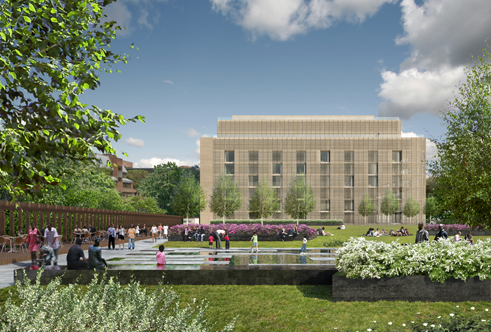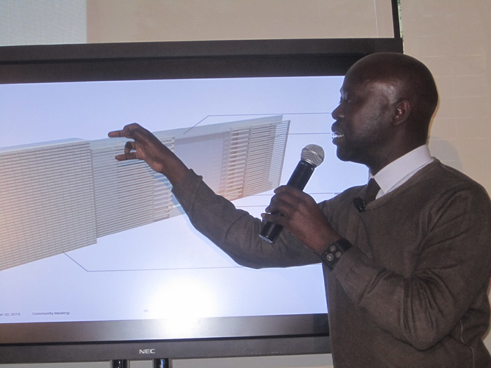Partial Demolition Eyed for Heating Plant

By Elizabeth WienerCurrent Staff Writer
The development team that wants to convert Georgetown’s West Heating Plant into luxury condos began building its case yesterday to demolish nearly 70 percent of the old structure, keeping the west wall and constructing a new 220,000-square-foot building that “evokes” the former facility on the same footprint.
“It’s now a block, an obstruction,” said architect David Adjaye at a well-attended briefing at the Four Seasons Hotel, which sits just north of the old federal heating plant and whose management would also operate the proposed residential building there. “This is an incredible moment, when you can make not just a building, but a place.”
As the briefing began, builder Richard Levy lowered the shades facing the hulking 1948 plant so attendees could focus on screens displaying the new design. “They’ve seen the building,” said Levy, a Georgetown resident who heads the development team, before introducing plans to transform what a Four Seasons staffer called “that ugly old building across the way.”
The Levy Group and Georgetown Co. bought the plant at auction for $19.5 million last March. Though it has been vacant for more than a decade, redevelopment is complicated because the structure sits within the Georgetown Historic District. Any exterior changes face scrutiny from the Old Georgetown Board, the D.C. Historic Preservation Review Board, and the Mayor’s Agent for Historic Preservation, who would have to approve the demolition.
But at the briefing, both Adjaye and structural engineer Kirk Mettam argued that substantial demolition is the only way to reclaim it. “This is not a building to be occupied. It’s a shell of an industrial plant,” he said.
Mettam said an initial inspection revealed “lots and lots of cracks” in the brick skin. A closer inspection, after the auction, was worse. Inside, engineers found that water had entered through the cracks, corroding and rusting the metal frame. And the brick skin, it turned out, was largely unattached to the metal frame. “Large unsupported spans of brick” could easily collapse at any disturbance, he said. “By the time you’re done trying to save it, you’ve taken it all down.”
Worse yet, the plant sits atop an aging public sewer line that’s still in use. The D.C. Sewer and Water Authority is deeply concerned that a restoration effort could cause the active sewer to crack, Mettam said.

Adjaye, a noted architect, said he studied the condition of the buff brick building, then asked himself, “Is there a way to preserve any part of it?” He concluded that only the 29th Street facade — “a noble structure” — along with the plant’s footing and foundation, could be salvaged, or about 33 percent of the original structure.
But in its place will be “a new building, of exactly the same materiality, which mimics, sort of rhymes with, the existing,” the architect said. “There’s a way to evoke the old building, but allow it to have a new life.”
There’s also a big sweetener in the plans — the 3.6 acres of parkland that would be created out of what is now a barren industrial site, inaccessible to the public and covered in part by rusting old tanks.
Landscape architect Ignacio Bunster, who also designed the nearby Georgetown Waterfront Park, has sketched in an elevated, gardenlike area to the south of the plant, with a historic C&O Canal lock to the north opened to the public, and a bike and pedestrian pathway wrapping around to the east, connecting the Rock Creek trail to the Georgetown waterfront.
The project has powerful backers. Former Mayor Anthony Williams is a partner on the development team, and Ward 2 D.C. Council member Jack Evans stopped by to argue that it would “bring life back to a site that is dead.” Among other benefits, Evans said, “it’s going to pay taxes. The people who live there [will pay income] taxes and property taxes on a building that now generates zero” revenue.
Levy noted that the start of construction could be several years away. The project will be presented to the Georgetown advisory neighborhood commission, and then to the Old Georgetown Board, in November. Mayor’s Agent hearings on the proposed demolition could be more than a year away.
The development team hopes to get a project website up by Monday, when complete drawings and other information should be available at westheatingplant.com.
This article appears in the Oct. 23 issue of The Georgetown Current newspaper.
